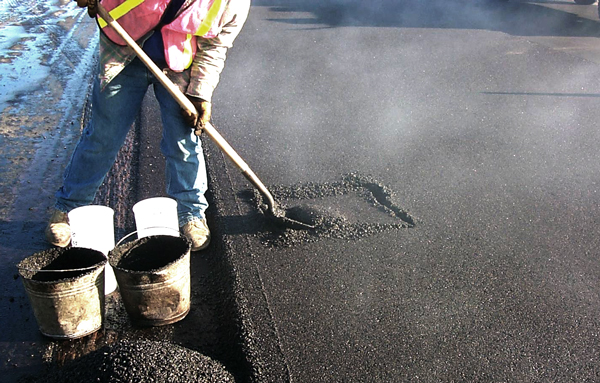Opening the Tricks of Warm Mix Asphalt Modern Technology
Discovering the midsts of warm mix asphalt technology reveals a globe where careful procedures and precise formulas merge to form our roads and facilities. The combination of fillers, binders, and aggregates isn't merely a construction job but a calculated orchestration of longevity and performance. As we peer right into the complex dance of components, a tapestry of resilience and sustainability unfolds. What lies under this surface area of asphaltic mastery, and what secrets wait to be introduced in the world of paving innovations?
Relevance of Hot Mix Asphalt
Hot Mix Asphalt plays an important function in modern-day framework development due to its resilience and cost-effectiveness. As the most frequently utilized leading product for roadways, freeways, and car park whole lots, Warm Mix Asphalt offers a range of benefits that contribute to its importance in construction projects.
The sturdiness of Hot Mix Asphalt comes from its structure, that includes aggregates, binder, and filler materials that are thoroughly picked and blended to satisfy details performance demands. This accurate mix leads to a strong and versatile sidewalk that can sustain constant usage without considerable deterioration. Furthermore, Hot Mix Asphalt is 100% recyclable, further boosting its sustainability and ecological benefits. Overall, the importance of Warm Mix Asphalt in facilities development can not be understated, as it remains to be a foundation of modern construction techniques.
Elements of Asphalt Mixes
The structure of asphalt mixes contains carefully chosen aggregates, binder, and filler products that are crucial for attaining specific efficiency requirements. Accumulations are the main part of asphalt mixes, giving strength and security. These accumulations can be natural, such as crushed rock or crushed stone, or artificial, like recycled materials from old pavements. The binder, commonly bitumen or asphalt concrete, holds the aggregates together and supplies flexibility and toughness to the mix. The option of the binder is important as it straight influences the mix's performance in various climate conditions. Fillers, such as hydrated lime or Rose city concrete, are used to enhance the mix's workability and aging resistance. Angled Parking.
The mix and percentage of these parts play a substantial role in determining the quality and performance of the asphalt mix. Engineers thoroughly develop the mix to satisfy certain demands, thinking about aspects like website traffic quantity, environment conditions, and pavement lifespan. Proper selection and balancing of accumulations, binder, and fillers are essential for developing sturdy, durable asphalt sidewalks.
Combining and Production Techniques

Once the aggregates are selected, the binder, typically asphalt cement, is contributed to bind the materials together. The binder's high quality and quantity substantially affect the mix's stamina, adaptability, and resistance to environmental factors. In addition, fillers like moisturized lime or Rose city cement may be incorporated to enhance details features of the asphalt mix, such as its workability or dampness resistance.
Throughout production, the aggregates and binder are warmed, commonly in between 250-325 ° F(121-163 ° C ), to assist in mixing and ensure correct layer of the accumulations. The mixing procedure has to be detailed to accomplish a homogeneous mixture that advertises the preferred performance features of the asphalt. Different techniques, such as set mixing or drum mixing, are used to accomplish consistent and high-grade asphalt blends for building projects.
Variables Impacting Asphalt Performance
Aspects influencing asphalt efficiency include a range of variables that affect the resilience, long life, and general top quality of asphalt pavements. One redirected here vital variable is the high quality of products utilized in the asphalt mix. The kind and source of accumulations, the binder quality, and the ingredients all play a significant function in determining the performance of the asphalt sidewalk. The gradation of aggregates is crucial as it impacts the mix's security, workability, and resistance to cracking and rutting.

Ecological conditions additionally influence asphalt efficiency. Temperature level variations, dampness infiltration, and website traffic tons can all impact the structural stability of the pavement. Design considerations, such as sidewalk density and drainage, are crucial in making sure the lasting performance of the asphalt sidewalk. By carefully thinking about these factors, specialists and designers can optimize asphalt performance and improve the life span of sidewalks.
Sustainable Practices in Asphalt Innovation

WMA permits for the production and positioning of asphalt mixes at lower temperature levels compared to typical hot-mix asphalt, resulting in decreased power consumption and greenhouse gas discharges. The usage of permeable asphalt blends can aid alleviate stormwater runoff issues by allowing water to infiltrate with the pavement and right into the ground, promoting all-natural water filtration and reenergize procedures.
Verdict
To conclude, hot mix asphalt innovation plays a critical role in modern facilities advancement because of its durability and cost-effectiveness. By thoroughly stabilizing elements, utilizing appropriate blending methods, and taking into consideration numerous variables, designers can develop high-grade asphalt blends that withstand rush hour lots and rough climate problems. Welcoming lasting methods, such as utilizing recycled materials and warm-mix innovations, further boosts the ecological kindness of asphalt innovation.
Mixing and manufacturing strategies in hot mix asphalt technology entail the specific mix and processing of aggregates, binder, and fillers to develop a high-performance and resilient asphalt mix.Elements i was reading this affecting asphalt efficiency encompass a range of variables that influence the toughness, durability, and total top quality of asphalt pavements. Lasting methods in asphalt technology incorporate different initiatives intended at decreasing the ecological effect of asphalt production and paving investigate this site procedures. By incorporating redeemed asphalt pavement (RAP) and recycled asphalt tiles (RAS) into brand-new asphalt mixes, the sector can substantially decrease the intake of raw materials and power, while also lowering landfill waste.
WMA permits for the production and positioning of asphalt mixes at lower temperature levels compared to typical hot-mix asphalt, resulting in decreased power consumption and greenhouse gas discharges.